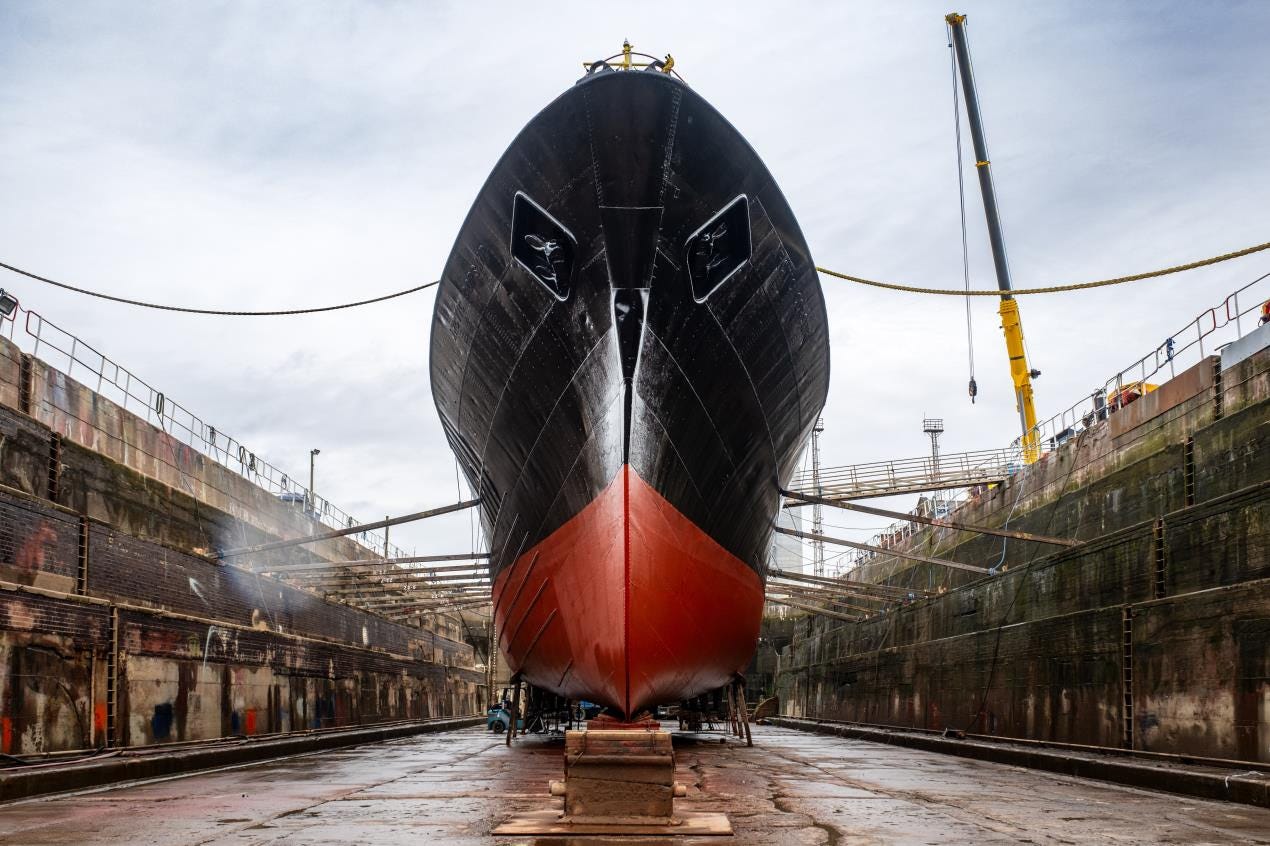Last week I took part in podcast for Curiosity Hull discussing the progress (or otherwise) of major infrastructure projects in Hull with presenter David Burns.
As proceedings drew to a close, Mr B said he felt like we were entering the Clutching at Straws Department. He had a point.
You can listen to it here https://curiosityhull.co.uk/curiositycast-ep-18-public-works-update/
We had touched on the Castle Street upgrade (delayed for 12 months), Drypool Bridge (closing in April for a six-month repair), the East Bank Village development (start date unknown), Albion Square (asbestos finally removed, demolition expected, finish date unknown) and the Maritime Museum refurbishment (completion date pushed back to early 2026).
Asked if the latter would impact on other schemes in the Hull Maritime programme, I said I assumed not although I did confess to having losing track of what was actually happening with the ambitious plans to relocate the restored Arctic Corsair trawler in a new dry-dock berth next to a purpose-built visitor centre overlooking the River Hull.
The proposed visitor attraction at the North End Shipyard;. Image: Hull City Council
Two days later whispers reached me about delays surrounding the vessel’s return. Old habits dies hard so with bit of digging through council reports, public notices and archived stories, I filled in the gaps. Finally, after asking for an official statement on the situation from Hull City Council, I got confirmation.
“Hull City Council has applied to the Marine Management Organisation (MMO), who are sponsored by the Department for the Environment, Food and Rural Affairs, for a license to remove 3,500 cubic metres of silt from the River Hull. This is to enable the installation of a new dock gate at the North End Shipyard and increase the navigable area of the channel to assist in the dry-docking process of the Arctic Corsair.
“However, the MMO has paused the application whilst it assesses the composition of the dredged material and the necessary disposal arrangements.
“In response, the council, working alongside naval architects, is responding to the MMO’s enquiries, and request for additional technical information which will be submitted to the MMO for consideration.
“These ongoing discussions have led to an unforeseen delay in the programme, which are not of the council’s making and will impact the delivery time of the project and add to its cost.
"We remain committed to resolving this as quickly as possible and will proceed once an approved solution is found.”
We’d taken the lift from the Clutching at Straws Department down into the basement and arrived at the Stuck in the Mud Department.
Without a dredging licence, it’s going to be tricky to get the 693-tonne former sidewinder trawler into the former North End Shipyard dry dock. The vessel no longer has a working engine and can only be moved under tow.
To avoid this potentially embarrassing worst-case scenario, the MMO has to be convinced that any removed silt will be safely disposed of before granting a licence.
The reference in the council statement to MMO’s need to assess the composition of the silt almost certainly points to the heart of the matter.
We’re talking about a river flanked by heavy industry for the best part of 200 years and although there’s much less of it these days, the Hull still drains a vast hinterland where intensive agricultural use means chemicals are used in abundance.
A check on the Environment Agency’s latest ecological rating for a nine-mile stretch of the river from Arram Beck north of Beverley to the Humber makes for bleak reading. According to the EA, this part of the river is “failing” when it comes to the presence of certain hazardous chemicals.
Ingredients in this toxic soup include mercury and polybrominated diphenyl ethers (PBDEs). In recent years, the latter have become identified as widespread environmental pollutants and harmful to human health. Remind me not to take a dip anytime soon.
There was no mention of a timeline in the council statement but it turns out the dredging application was submitted to the MMO in April last year. On its website, the MMO says it aims to make decisions on most licence applications within 13 weeks of an application being validated. It adds: “However, each application is different and some applications will take longer than this, while others will take less time.”
Reading between the lines and according to a couple of well-informed sources, the paused Hull application suggests a degree of stalemate over the issue. Quite literally stuck in mud?
The MMO tells applicants: “Your application will not be progressed until the required information has been provided and your application may be rejected if it does not contain all the information needed. You (the applicant) are responsible for providing sufficient information with your application in order for us to assess it. This must include details about the activities you wish to carry out as well as information on the likely impacts associated with them.
“There may be occasions where further information is required. If this is the case, we will provide details of what is required and the timescale in which it should be received. Failure to provide the information may result in a decision to refuse to proceed with your application.”
In each application, the MMO is required to consider the need to protect the environment and human health while preventing interference with other legitimate uses of the sea.
Licences can be granted with or without conditions as well as being refused. Appeals can be lodged against refusals within six months of a decision and are determined by an independent inspector. Appeal decisions can be challenged by judicial review.
The Arctic Corsair in dry dock at William Wright Dock. Image: Hull City Council
All of which suggests to me that the Arctic Corsair is going to spend even more time at its current berth in William Wright Dock following restoration work by ship repair firm Dunston’s.
The MMO maintains it encourages the resolution of outstanding issues and differences of opinion on a proposed scheme during the application process to avoid the prospect of a potentially costly appeal. Let’s hope an agreed way forward can be achieved in this case.
The latest delay has also revived the long-standing public debate about dredging in the River Hull.
You don’t have to be a marine sediment specialist to spot how high silt levels are in the river at low tide as it runs through the city towards its confluence with the Humber. Washed into the river from both the Humber and from its northern catchment area, the silt has steadily accumulated in recent years while dredging in the river has all but stopped.
The River Hull near the former Scott Street Bridge
Unless I’m mistaken, dredging in the river as it runs through the city centre only takes place around once a year or when it’s required usually in the Old Harbour area between Drypool Bridge and Scale Lane Bridge. The process sees silt removed to a depth of 0.5m below the lowest tide level before being dispersed back into the water.
Calls for the return of more frequent dredging are often made with references to how it routinely happened in the past. However, that ignores sweeping changes in environmental legislation around the issue, particularly on the disposal of excavated material. Many also argue that regular dredging of the river is necessary to reduce the risk of flooding. The argument is comprehensively debunked here and it’s worth a read.
https://www.ciwem.org/assets/pdf/Policy/Reports/Floods-and-Dredging-a-reality-check.pd
It’s also worth pointing out that regular dredging in the Humber is a different kettle of fish altogether. The high volume of commercial marine traffic on the estuary means access to the docks on either side has to be guaranteed while the navigational channels which historically shift with the currents also makes dredging essential. In the estuary itself, the bulk of the sediment shifted by dredging is sand while in the River Hull it’s clay-based silt.
Dredged material in the Humber is disposed of usually at the nearest location within the estuary from where it is removed. As such, the only likely option for the silt earmarked for removal in the River Hull at the North End Shipyard would be somewhere close by in the Humber.
The Hull Maritime project, which includes the Arctic Corsair scheme, was first announced in 2017. Encouraged by its success in bidding to become the UK City of Culture that year, the council aimed high and secured a £15m grant from the National Lottery Heritage Fund towards the cost. As part of the award, the council itself committed £15m. The current budget estimate for the Hull Maritime project is £40.5m and that excludes an extra £2.5m for the dredging work in what a council report describes as “potential risk” .
Perhaps we are witnessing the last in a cycle of big council-led regeneration projects in Hull. When Labour regained control of the council from the Lib Dems in 2011 austerity funding cuts to local government were starting to bite. In a choice between fighting back or managing decline, Labour opted for a DIY approach to boost the local economy with the City of Culture and Lottery Heritage Fund bids being examples of thinking big and being bold.
Today, if anything, the financial situation facing local councils is even worse than a decade ago. Meanwhile, the Lib Dems are back in power at the Guildhall and are living up to their reputation of being politically risk-averse when given the opportunity to govern. As such, it came as no surprise when, within days of taking office, Lib Dem leader Mike Ross pulled the plug on plans to build a cruise terminal next to The Deep. Instead, the Lib Dem mantra seems to be back to basics with an emphasis on street cleaning, pothole repairs and funding small-scale neighbourhood initiatives.
I’m sure there will be deep sighs of relief when the Corsair arrives at her final resting place, wherever that might be. Until then, I suspect many people will be keeping their fingers tightly crossed that it will happen at all.






